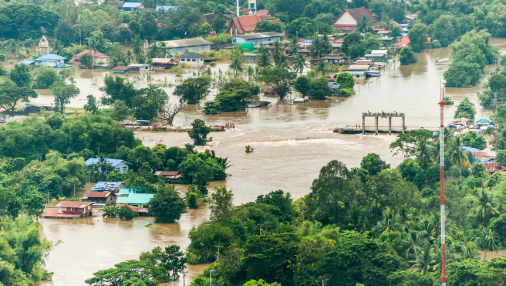Uttarkashi Cloudburst: Flash Floods in Uttarakhand Leave Four Dead; Over 60 Feared Trapped
Uttarkashi, Uttarakhand — August 2025: A devastating cloudburst in the Mori block of Uttarkashi district triggered flash floods late Saturday night, leaving at least four people dead and more than 60 individuals feared trapped under debris and washed away structures. This tragic incident adds yet another chapter to Uttarakhand’s long history of monsoon-related disasters, raising fresh concerns over the region's vulnerability to extreme weather events.
The Cloudburst: A Night of Devastation
The cloudburst occurred around 2:30 AM IST near Dholasu village, unleashing torrential rain over a very short span. According to the India Meteorological Department (IMD), approximately 100 mm of rainfall was recorded in under an hour — an intense downpour that overwhelmed the region’s fragile ecosystem.
Eyewitnesses recount a night of chaos and terror. “It started with a loud rumble, and within minutes, water mixed with mud and debris was flowing into our homes,” said Suresh Rawat, a local villager who managed to escape with his family. Many others were not so fortunate. Homes built along riverbanks were the first to be swept away, with several small bridges and portions of roads collapsing under the sheer force of the water.
Casualties and Rescue Operations
As of Sunday afternoon, four bodies have been recovered — including a woman and a child — from the debris near Saini Gaon and Arakot villages. However, district officials fear the death toll may rise as over 60 people are still unaccounted for, presumed to be trapped under mudslides or carried away by swollen streams.
Rescue operations have been launched under the supervision of the State Disaster Response Force (SDRF), National Disaster Response Force (NDRF), and personnel from the Indo-Tibetan Border Police (ITBP). However, persistent rainfall and damaged road connectivity have made access to several affected villages nearly impossible.
“We are facing significant challenges in reaching remote hamlets,” said SDM Mori, Deepak Rawat. “Helicopters are on standby, but low visibility and bad weather are hampering aerial surveys and rescue drops. Time is critical.”
Uttarakhand’s Monsoon Woes: A Recurring Nightmare
The Uttarkashi disaster is not an isolated event. Every monsoon season, Uttarakhand witnesses flash floods, landslides, and cloudbursts, resulting in loss of lives, property, and infrastructure. The fragile Himalayan topography, combined with unplanned urbanization, deforestation, and a changing climate, has made the region increasingly susceptible to such calamities.
Environmental experts have been warning about the intensifying pattern of cloudbursts in Uttarakhand. “The atmosphere now holds more moisture due to rising temperatures, leading to sudden, high-intensity downpours,” explains Dr. Ranjana Bhatt, a climate scientist at GB Pant National Institute of Himalayan Environment. “Unfortunately, these bursts often occur in eco-sensitive zones where human settlements and infrastructure development should have been strictly regulated.”
Government Response & Relief Measures
Uttarakhand Chief Minister Pushkar Singh Dhami expressed deep condolences to the families of the deceased and announced an ex-gratia of ₹4 lakh for each victim’s family. He also assured that all efforts are being made to trace and rescue the missing persons.
“Teams are working around the clock, despite the challenging weather. We have mobilized every possible resource. Relief camps have been set up for displaced families,” Dhami said in a statement.
Meanwhile, the Uttarkashi District Administration has urged people living in low-lying and landslide-prone areas to move to safer locations temporarily. The Char Dham Yatra routes, particularly the Yamunotri and Gangotri highways, have been temporarily closed due to landslides, impacting thousands of pilgrims.
Challenges Ahead: The Need for Better Preparedness
While the immediate priority remains rescue and relief, the Uttarkashi tragedy underscores deeper systemic issues. Despite Uttarakhand's history of natural disasters — from the catastrophic Kedarnath floods in 2013 to the Chamoli glacier burst in 2021 — disaster preparedness remains reactive rather than proactive.
Several affected villages, such as Makudi, Tikochi, and Arakot, lack basic early warning systems or proper evacuation plans. Experts argue that the deployment of real-time flood monitoring systems, stricter zoning regulations, and community-level disaster drills could significantly mitigate the impact of such events in the future.
The Role of Climate Change & Human Interference
There is a growing consensus among environmentalists that climate change is intensifying the frequency of such extreme weather phenomena in the Himalayan belt. However, the role of unchecked construction, rampant deforestation, and riverbed encroachments cannot be ignored.
“In the name of development, we have weakened the natural defenses of our mountains,” said Anil Joshi, an environmental activist based in Dehradun. “Cloudbursts are natural phenomena, but the scale of devastation we are seeing is largely man-made. Unless we align infrastructure development with ecological sensitivity, these disasters will only get worse.”
Conclusion: A Wake-up Call for Uttarakhand
The Uttarkashi cloudburst of August 2025 is a stark reminder of the delicate balance between nature and human habitation in the Himalayan region. While immediate rescue and relief are paramount, long-term solutions focusing on sustainable development, early warning infrastructure, and environmental conservation are critical.
As Uttarakhand grapples with yet another tragedy, the question remains: How many more disasters will it take before policymakers, developers, and citizens acknowledge the urgent need for climate-resilient planning in these ecologically fragile zones?

